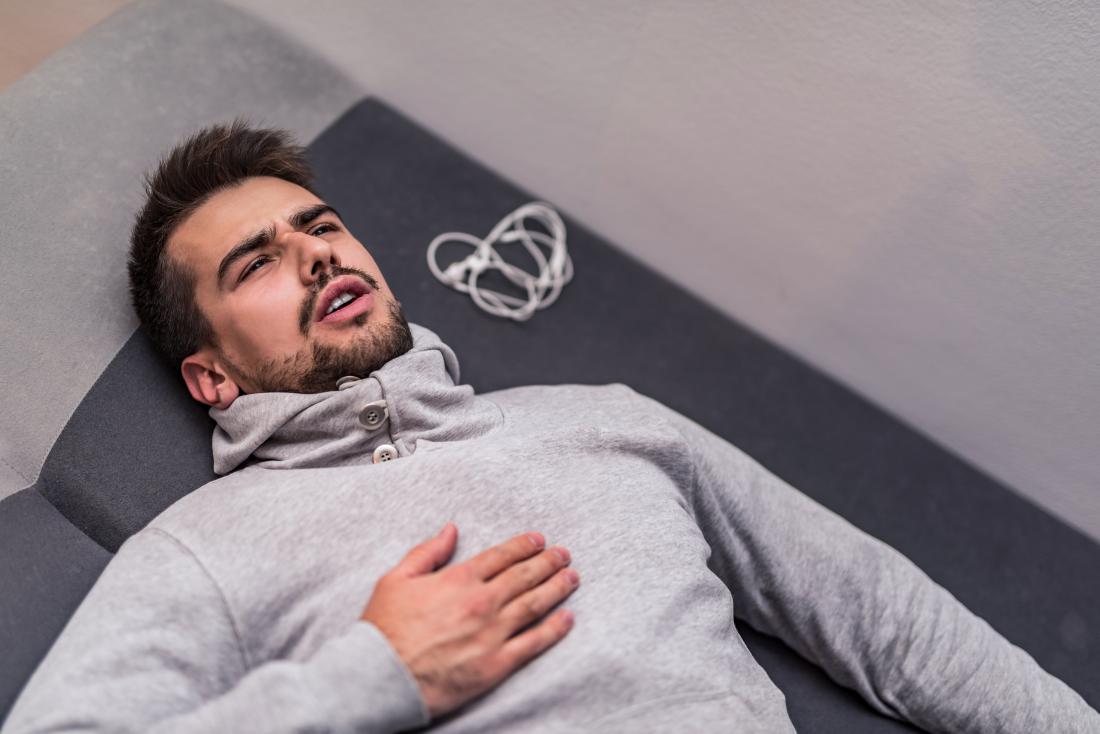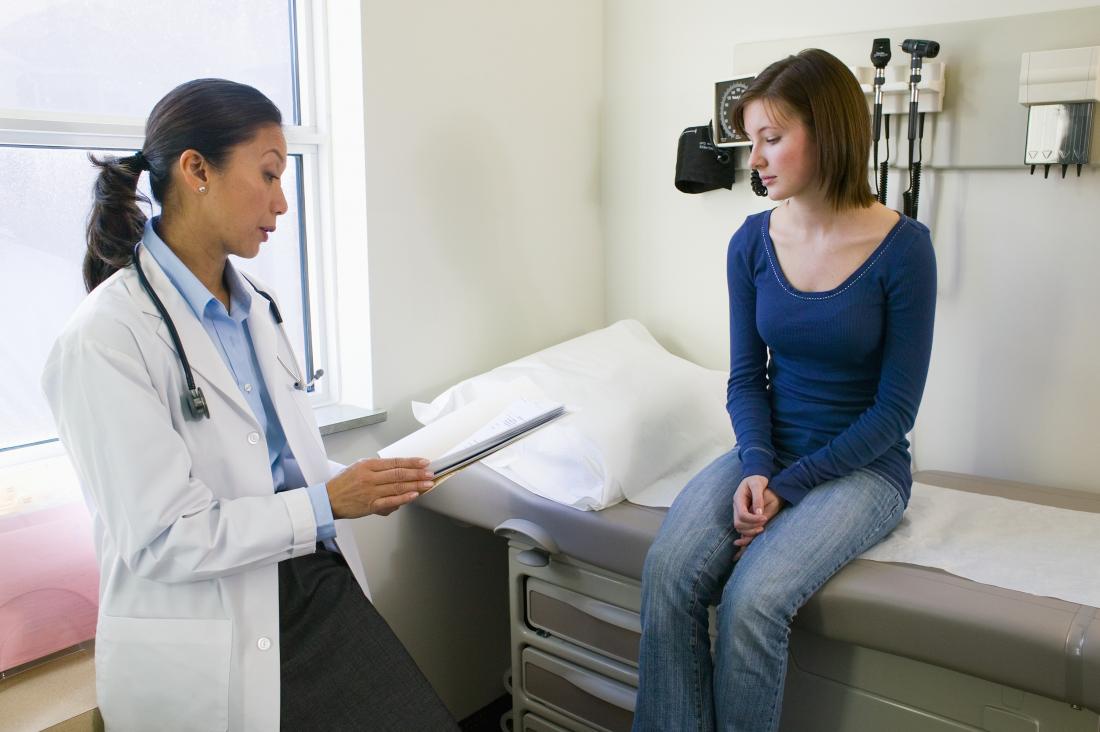A strain or injury are common causes of pain under the right breast, and the pain usually gets better on its own. However, it can also result from conditions affecting the underlying tissues and organs, or the pain may be extending from another area of the body, such as the stomach.
In this article, we explore some potential causes of pain under the right breast, along with their main symptoms and treatments. We also describe when to see a doctor.
Injury

An injury or muscle strain can cause pain under the right breast.
Injuries to the ribs or chest area are common and can be very painful. Depending on where the injury occurs, this pain may manifest under one or both of the breasts.
Possible causes of chest injuries include:
- knocks or blows to the chest area
- falls
- severe coughing
Other symptoms of an injury can include swelling and bruising. More forceful injuries can also result in bruised or fractured ribs.
People recovering from surgery to the breasts or chest area may also experience pain or discomfort under one or both breasts.
Treatment
A person can usually treat minor chest injuries at home with rest and over-the-counter (OTC) medications, such as acetaminophen and ibuprofen.
Applying ice to the affected area for up to 20 minutes at a time may also help reduce pain and swelling.
See a doctor for pain that results from a serious injury, such as a car accident. People with severe or worsening pain should also speak to a doctor.
Muscle strain
It is possible to strain or overstretch the chest muscles, which can result in soreness and pain. Depending on which muscles a person strains, this pain may occur under a single breast.
Chest muscle strains can result, for example, from throwing, heavy lifting, and using heavy tools or equipment.
Treatment
Muscle strains usually get better with rest. OTC pain relievers and applying ice to the affected area for up 20 minutes at a time may help reduce chest discomfort.
Menstrual cycle
Hormonal fluctuations that occur during the menstrual cycle can cause the breasts to become swollen and tender.
This tenderness usually occurs in the week or so before a person’s period, and it can affect one or both breasts.
Treatment
Taking OTC pain relievers and drinking plenty of water can help reduce breast tenderness from menstrual hormonal changes. The symptoms usually resolve before a person’s period is over.
Costochondritis
Costochondritis is an inflammation of the cartilage in the costochondral joint, which is the area where the ribs meet the sternum, also called the breastbone.
The main symptom of costochondritis is chest pain, which can occur in one or both sides of the chest. This pain can be dull or sharp and may get worse when taking a deep breath or coughing. There may also be tenderness around the breastbone.
Costochondritis does not usually cause severe symptoms, such as shortness of breath, fever, or dizziness.
Doctors do not fully understand what causes costochondritis, but it may result from one or more of these issues:
- chest injuries
- intense physical activity
- strenuous coughing
- illness, such as a chest infection near the costochondral joint
Treatment
Costochondritis often gets better on its own, but it may last several weeks.
Some ways to relieve inflammation and pain from costochondritis:
- avoiding activities that stress or aggravate the chest area
- applying heat packs to the affected area
- taking nonsteroidal anti-inflammatory drugs — NSAIDs — such as naproxen or ibuprofen
For pain that gets worse or does not go away, a doctor may recommend steroid injections or physical therapy.
Gallstones

A person who experiences a gallbladder attack should seek treatment.
The gallbladder is a small organ on the right side of the body that stores bile from the liver. If bile contains too much cholesterol or bilirubin, or if a person’s gallbladder does not empty properly, gallstones can form.
Most gallstones pass without causing problems. However, gallstones that block the flow of bile in the bile ducts can cause pain and inflammation. The episodes of pain resulting from these blockages are called gallbladder attacks or biliary colic.
The pain from a gallbladder attack usually occurs in the upper right abdomen and can last for several hours.
Attacks that last for more than a few hours can lead to complications. For instance:
- jaundice, which is yellowing of the skin and eyes
- nausea and vomiting
- fever
Treatment
Anyone who has had a gallbladder attack should see a doctor, even if symptoms get better, because more attacks may follow. People who experience complications should receive prompt medical attention.
If gallstones continue to cause problems, doctors usually recommend surgery to remove the gallbladder. The gallbladder is not an essential organ, and removal reduces the risk of it becoming infected and causing further complications.
For people who cannot undergo gallbladder removal, doctors may recommend some of the following nonsurgical treatments:
- endoscopic retrograde cholangiopancreatography
- oral dissolution therapy
- shock wave lithotripsy
Hiatal hernia
A hiatal hernia occurs when part of the stomach slides up through the hiatus, which is an opening in the diaphragm. The diaphragm is a large, thin sheet of muscle that separates the chest cavity from the abdomen.
Hiatal hernias do not always cause noticeable symptoms, but they can increase a person’s risk of gastroesophageal reflux disease (GERD). Some examples of symptoms:
- chest pain
- heartburn
- problems swallowing
- shortness of breath
- nausea and vomiting
Treatment
Treatment is usually necessary if the hiatal hernia is causing problems. For people with symptoms of GERD, treatment options include:
- lifestyle and dietary changes, such as maintaining a healthy weight and avoiding foods that make symptoms worse
- medications that reduce stomach acid, such as antacids, H2 receptor blockers, and proton pump inhibitors
If these treatments are unsuccessful, a doctor may recommend surgery to correct the hernia.
Irritable bowel syndrome
Irritable bowel syndrome (IBS) causes gastrointestinal symptoms, such as abdominal pain and changes to a person’s bowel movements. These symptoms tend to vary in type and severity from person to person.
Some symptoms of IBS:
- bloating and gas
- constipation or diarrhea
- a feeling of incomplete evacuation after having a bowel movement
- stools containing a whitish mucus
IBS can sometimes also cause referred pain, including right-sided chest pain.
Treatment
Treatment for IBS typically includes some of the following lifestyle and dietary changes:
- increasing fiber intake
- exercising regularly
- reducing and managing stress
- getting enough sleep
- following a specific diet, such as the low-FODMAP diet.
FODMAP is an acronym for oligo-, di-, monosaccharides, and polyols, which are groups of carbs that can cause digestive symptoms, including bloating, gas, and pain.
Doctors may also prescribe specific medications to reduce constipation, diarrhea, and abdominal pain.
Pleural disorders

Shortness of breath and chest tightness are potential symptoms of pleural disorders.
The pleurae make up a large, thin membrane that is folded over to form two layers. One layer wraps around the lungs, and the other lines the inside of the chest cavity. The space between these two layers is called the pleural space.
Inflammation of the pleura is called pleurisy, and it can cause the two layers to rub against each other. This friction can lead to sharp chest pain when coughing or breathing deeply.
In different pleural disorders, air, gas, fluid, or blood collects in the pleural space, which can also cause sharp chest pain.
Other symptoms of pleural disorders:
- coughing
- fever and chills
- shortness of breath
- fatigue
- chest tightness
- weight loss
- a bluish tint to the skin
Treatment
Treatment for a pleural disorder depends on the underlying cause and the severity of a person’s symptoms.
For example, if a bacterial infection is causing the condition, a doctor may prescribe antibiotics. They may also recommend anti-inflammatory medications or pain relievers to help reduce a person’s discomfort.
Some people require a procedure to drain gas or fluids from the pleural space.
Pneumonia
Pneumonia is infectious inflammation of the tiny air sacs in the lungs, which causes them to fill up with fluid. It can lead to a range of symptoms, including sharp chest pain that typically gets worse with deep breathing or coughing.
Other symptoms of pneumonia:
- fever and chills
- a persistent cough that produces green, yellow, or bloody mucus
- a loss of appetite
- fatigue and low energy levels
- confusion
- nausea
- shortness of breath or other breathing difficulties
Early symptoms of pneumonia can be similar to a common cold or the flu and may come on suddenly or gradually worsen over a few days. Symptoms can vary from mild to severe.
The most common cause of pneumonia is a bacterial infection, but pneumonia can also result from viral or fungal infections.
Treatment
People with symptoms of pneumonia should see a doctor. Seek urgent medical attention if symptoms are severe.
Pneumonia can sometimes lead to life-threatening complications, and some people require hospitalization.
Treatment depends on the type of pneumonia and the severity of symptoms. Doctors may prescribe antibiotics for bacterial pneumonia or antiviral medications for viral pneumonia.
To treat mild pneumonia at home, a doctor may recommend the following:
- getting plenty of rest
- drinking lots of fluids
- taking OTC pain relievers
- avoiding tobacco smoke and other lung irritants
- taking oral antibiotic or oral antiviral therapy, as prescribed
When to see a doctor
See a doctor if the pain under the right breast gets worse, does not go away, or is interfering with daily activities. Also, seek medical attention if the pain accompanies other concerning symptoms.
Some symptoms that require immediate medical attention:
- severe, sharp, or sudden chest pain
- chest pain that radiates to other parts of the body, such as the jaw, arms, or shoulders
- a bluish tint to the lips or skin
- difficulty breathing
- coughing up blood
- confusion, dizziness, or loss of consciousness
Summary
Pain under the right breast is rarely a cause for concern and often results from muscles strains or minor injuries.
However, it can indicate a more serious condition, such as an infection, chest inflammation, or a gastrointestinal issue.
If the pain gets worse, does not go away, or occurs with other concerning symptoms, see a doctor. Seek immediate medical attention for severe chest pain or pain that accompanies breathing difficulties.

